
Rachel Aliene Corrie was an American activist and diarist. She was a member of the pro-Palestinian International Solidarity Movement (ISM) and was active throughout the Israeli-occupied Palestinian territories. In 2003, Corrie was in Rafah, a city in the Gaza Strip, where the Israeli military was demolishing Palestinian houses at the height of the Second Intifada. While protesting the demolitions as they were being carried out, she was crushed to death and killed by an Israeli armored bulldozer.
The International Solidarity Movement is a Palestinian-led movement focused on assisting the Palestinian cause in the Israeli–Palestinian conflict. ISM is dedicated to the use of nonviolent protests and methods only. The organization calls on civilians from around the world to participate in acts of nonviolent protests against the Israeli military in the West Bank and the Gaza Strip.

Thomas Hurndall was a British photography student, a volunteer for the International Solidarity Movement (ISM), and an activist against the Israeli occupation of the Palestinian territories. On 11 April 2003, he was shot in the head in the Gaza Strip by an Israel Defense Forces (IDF) sniper, Taysir Hayb. Hurndall was left in a coma and died nine months later.
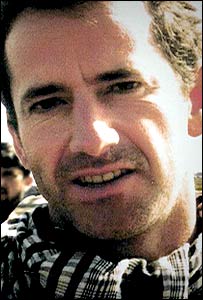
James Henry Dominic Miller was a Welsh cameraman, producer, and director, and recipient of numerous awards, including five Emmy Awards. He was killed by Israel Defense Forces (IDF) gunfire while filming a documentary in the Gaza Strip. Miller worked regularly with Saira Shah for several years, and they formed a business partnership to operate an independent production company called Frostbite Productions in 2001.

On 30 September 2000, the second day of the Second Intifada, 12-year-old Muhammad al-Durrah was killed in the Gaza Strip during widespread protests and riots across the Palestinian territories against Israeli military occupation. Jamal al-Durrah and his son Muhammad were filmed by Talal Abu Rahma, a Palestinian television cameraman freelancing for France 2, as they were caught in crossfire between the Israeli military and Palestinian security forces. Footage shows them crouching behind a concrete cylinder, the boy crying and the father waving, then a burst of gunfire and dust. Muhammad is shown slumping as he is mortally wounded by gunfire, dying soon after.
Idier Wahid Taysir Hayb Bedouin Israeli sergeant who shot International Solidarity Movement civilian activist Tom Hurndall, while on duty in Gaza on April 11, 2003. Hurndall died in January 2004, after a nine-month coma. Hayb was sentenced to eight years for manslaughter. His sentence was reduced in July 2010. He is the brother of Amira al Hayb, the first Bedouin Israeli female to join the IDF.

Efraim "Effi" (Fine) Eitam is an Israeli brigadier general, former commander of the 91st Division, and a fascist politician. A former leader of the National Religious Party, he later led a breakaway faction, Ahi, which merged into Likud in 2009. He served as a member of the Knesset between 2003 and 2009.

Iain John Hook was a British aid worker and military officer who worked for the United Nations Relief and Works Agency for Palestine Refugees in the Near East (UNRWA) as project manager in the rebuilding of Jenin Refugee Camp in West Bank, which was home to 13,000 Palestinian refugees. After Hook left a voice message with Israeli authorities that Palestinian militants ("shabab"-youth) had "knocked a hole in the wall" and "pinned down" his men, during an engagement in Jenin he was shot and killed by an Israel Defense Forces sniper. Israeli Army radio said that the sniper who killed him mistook his cell phone for a handgun or grenade. A United Nations Security Council resolution condemning Israel was vetoed by the United States. In 2005, a British inquest jury returned a verdict of unlawful killing.

Michael Sfard is a lawyer and political activist specializing in international human rights law and the laws of war. He has served as counsel in various cases on these topics in Israel. Sfard has represented a variety of Israeli and Palestinian human rights and peace organizations, movements and activists at the Israeli Supreme Court.
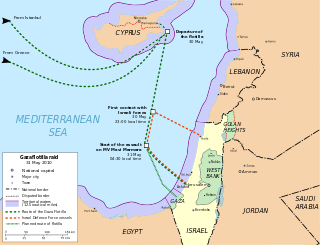
The Gaza flotilla raid was a military operation by Israel against six civilian ships of the "Gaza Freedom Flotilla" on 31 May 2010 in international waters in the Mediterranean Sea. Nine of the flotilla passengers were killed during the raid, with thirty wounded. Ten Israeli soldiers were wounded, one seriously. The exact sequence of events is contested, in part due to the IDF's confiscation of the passengers' photographic evidence. The flotilla, organized by the Free Gaza Movement and the Turkish Foundation for Human Rights and Freedoms and Humanitarian Relief (İHH), was carrying humanitarian aid and construction materials, intending to break the Israeli-Egyptian blockade of the Gaza Strip.
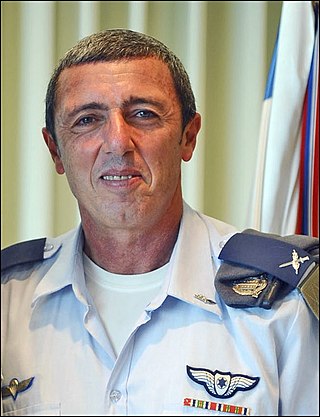
Rafael "Rafi" Peretz is an Israeli Orthodox rabbi and former politician. A former military officer and helicopter pilot who also served as the Chief Military Rabbi of the Israel Defense Forces, he was the leader of the Jewish Home party. Peretz was a member of the Knesset for the Yamina alliance until he separated from the faction in order to join the Netanyahu-led government.
The August 2010 West Bank shooting attack was an attack near the Israeli settlement of Kiryat Arba in the Israeli-occupied West Bank, carried out by Hamas militants. Four Israeli settlers from the settlements of Beit Hagai and Efrat were killed after militants attacked their vehicle. It was the deadliest Palestinian attack on Israelis in over two years.
The Beitunia killings refers to the consecutive killings of two Palestinian teenagers, which took place on the occasion of the annual Nakba Day protests on May 15, 2014, near the Israeli Ofer Prison outside Beitunia in the occupied West Bank. Israel described the protest as a riot in which a crowd refused to disperse, and initially denied responsibility, saying the cause of the deaths was unknown, the deaths were faked, that video clips of the killings either failed to capture the violence of the scene shortly before or might have been manipulated, that soldiers had been provoked and that only rubber bullets had been fired.
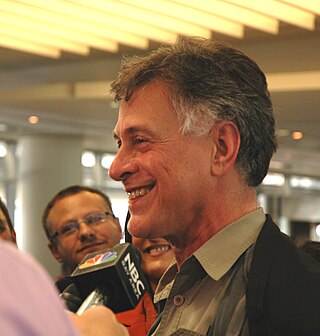
Paul Larudee (born April 25, 1946) is an Iranian-born American political activist who is a major figure in the pro-Palestinian movement. Based in the San Francisco Bay area, he is involved with the International Solidarity Movement and was a founder of the Free Gaza Movement and the Free Palestine Movement.
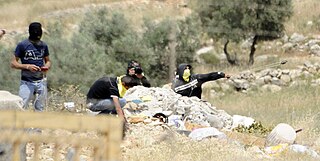
Palestinian stone-throwing refers to a Palestinian practice of throwing stones at people or property. It is a tactic with both a symbolic and military dimension when used against heavily-armed troops. Proponents, sympathizers, as well as analysts have characterized stone throwing by Palestinians as a form of "limited", "restrained", "non-lethal" violence. The majority of Palestinian youths engaged in the practice appear to regard it as symbolic and non-violent, given the disparity in power and equipment between the Israeli forces and the Palestinian stone-throwers, with many considering it a method of deterring Israeli military forces and civilians from the occupation of Palestinian lands. The state of Israel considers the act to be criminal, on the grounds that it is potentially lethal. In some cases, Israelis have argued that it should be treated as a form of terrorism, or that, in terms of the psychology of those who hurl stones, even in defense or in protest, it is intrinsically aggressive.
This is a list of individual incidents and statistical breakdowns of incidents of violence between Israel and Palestinian dissident factions in 2014 as part of the Israeli–Palestinian conflict.
Abdel Fattah al-Sharif, a Palestinian who had stabbed an Israeli soldier, was fatally shot on March 24, 2016, in the Tel Rumeida neighborhood of Hebron, by Elor Azaria, an Israeli Defense Forces (IDF) soldier. Azaria shot Abdel Fattah al-Sharif in the head as the latter lay wounded on the ground. Azaria was arrested and the Israeli Military Police opened an investigation against him for the charge of murder, but later reduced the charge to manslaughter.
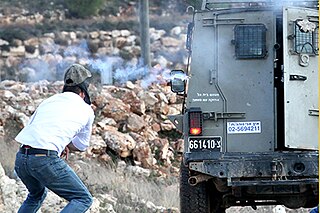
Mustafa Tamimi, a 28-year-old Palestinian taxi driver, was killed when he was hit by a tear gas canister by Israeli forces fired from close range and striking him directly in the face on 9 December 2011 during a weekly protest in Nabi Salih, West Bank. The tear gas canister that struck him was fired from the rear door of a military vehicle at which he was throwing stones while running after it. The incident raised questions about Israeli military behavior when engaging with the demonstrators.

Gaza-Israel clashes began on 11 November 2018, when a botched Israeli covert operation carried out in the Khan Yunis area of the southern Gaza Strip killed seven Palestinian militants and one Israeli soldier. Exchanges of fire lasted for two more days, until a cease fire was achieved with Egyptian mediation. Some minor incidents and protests followed some two weeks after the cease fire, with decreasing intensity.
On 15 December 2023, Israel Defense Forces (IDF) soldiers operating in Shuja'iyya, Gaza as part of the 2023 Israeli invasion of the Gaza Strip shot dead three Israeli hostages taken during the 2023 Hamas-led attack on Israel. The hostages, who were trying to be rescued, were visibly unarmed and shirtless and waving a makeshift white flag when they were killed. The incident provoked criticism of the IDF and of the government's attempts to resolve the hostage crisis with military action within Israel and condemnation of Israeli military action in Gaza from abroad.












